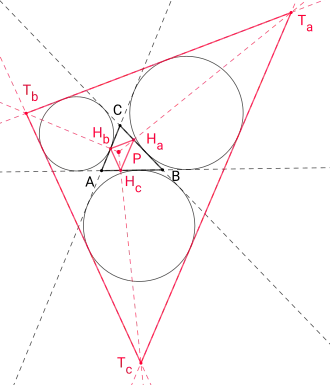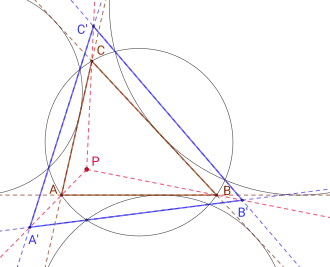In Euclidean geometry, the Clawson point is a special point in a triangle defined by the trilinear coordinates tan α : tan β : tan γ,[1] where α, β, γ are the interior angles at the triangle vertices A, B, C. It is named after John Wentworth Clawson, who published it 1925 in the American Mathematical Monthly. It is denoted X(19) in Clark Kimberling's Encyclopedia of Triangle Centers.
Geometrical constructions
There are at least two ways to construct the Clawson point, which also could be used as coordinate free definitions of the point. In both cases you have two triangles, where the three lines connecting their according vertices meet in a common point, which is the Clawson point.
Construction 1

For a given triangle △ABC, let △HAHBHC be its orthic triangle and △TATBTC the triangle formed by the outer tangents to its three excircles. These two triangles are similar and the Clawson point is their center of similarity, therefore the three lines TAHA, TBHB, TCHC connecting their vertices meet in a common point, which is the Clawson point.[2][3]
Construction 2

For a triangle △ABC, its circumcircle intersects each of its three excircles in two points. The three lines through those points of intersections form a triangle △A'B'C'. This triangle and △ABC are perspective triangles with the Clawson point being their perspective center. Hence the three lines AA', BB', CC' meet in the Clawson point.[1]
History
The point is now named after J. W. Clawson, who published its trilinear coordinates 1925 in the American Mathematical Monthly as problem 3132, where he asked for geometrical construction of that point.[4] However the French mathematician Émile Lemoine had already examined the point in 1886.[5] Later the point was independently rediscovered by R. Lyness and G. R. Veldkamp in 1983, who called it crucial point after the Canadian math journal Crux Mathematicorum in which it was published as problem 682.[1]
References
- 1 2 3 Clark Kimberling: CLAWSON POINT. In: Encyclopedia of Triangle Centers (retrieved 2019-11-30)
- ↑ Clark Kimberling: Central Points and Central Lines in the Plane of a Triangle. In: Mathematics Magazine, Volume 67, no. 3, 1994, pp. 163–187, in particular 175. (JSTOR).
- ↑ Weisstein, Eric W. "Clawson Point". MathWorld. (retrieved 2019-11-30)
- ↑ J. W. Clawson, Michael Goldberg: problem 3132. In: The American Mathematical Monthly, Volume 33, no. 5, 1926, pp. 285–285. (JSTOR)
- ↑ Clark Kimberling: X(19)=CLAWSON POINT. In: Encyclopedia of Triangle Centers (retrieved 2019-11-30)
External links
- Weisstein, Eric W. "Clawson Point". MathWorld.
- X(19)=CLAWSON POINT und CLAWSON POINT at the Encyclopedia of trinagle Centers (ETC)
- LE POINT CLAWSON PAR LES TRIANGLES ORTHIQUES ET EXTANGENT
- Clawson Point: Orthic Triangle, Extangents Triangle, Homothecy or Homothety